3 Minutes with Richard Streitmatter-Tran

Richard Streitmatter-Tran was born in 1972 in Bien Hoa, Vietnam. He received his degree in the Studio for Interrelated Media (SIM) at the Massachusetts College of Art in Boston. For the first decade of his career Richard’s artwork could be described as strictly conceptual, but after 2013 he began to focus on producing artwork that required a meticulous level of fine craftsmenship. As a result, his current body of work is both rooted in the conceptual rigor of contemporary art theory and the skills behind traditional techiques.
Richard has also been an arts correspondent for the Madrid-based magazine Art.Es and the Ho Chi Minh City editor for the magazine Contemporary. He has published in several books, catalogs and journals. In 2005 he received the Martell Contemporary Asian Art Research Grant from the Asia Art Archive in Hong Kong for his year-long research project, Mediating the Mekong. He was a Teaching Assistant at Harvard University (2000-2004), conducted media arts research at the MIT Media Lab (2000) and a visiting lecturer at the Ho Chi Minh Fine Arts University in 2003-4. He was an advisor to the Para/Site Curatorial Programme in Hong Kong and the San Art Artist Residency program in Ho Chi Minh City. From 2006 – 2015 he was Senior Lecturer at RMIT International University Vietnam. Richard will be an artist in residency at the Centre of Contemporary Art (CCA) in Singapore in 2017.
His recent solo and collaborative work has been exhibited internationally including “Mekong – New Mythologies,” Hong Kong Arts Centre, Hong Kong (2017); “Odyssey,” Singapore Art Museum, Singapore (2016); Jarkarta Ceramics Biennle, Indonesia (2016); “Secret Archipeligo,” Palais de Tokyo, Paris, France (2015); ‘Doubt and Believe: Exhibition of Nguyen Son and R. Streitmatter-Tran,” Womens Art Museum, Hanoi, Vietnam (2013); “Panorama: Recent Art from Contemporary Asia,” Singapore Art Museum, Singapore (2012); “Guangzhou Triennale 4: Art Domain Migration,” Guangzhou, China (2011); “Institution for the Future,” Asia Triennial, Manchester, United Kingdom (2011); FAX” Para/site Art Space, Hong Kong (2010); “Transportasian: Photography from Southeast Asia,” Signapore Art Museum (2009); “Wonder,” Singapore Biennale, Singapore (2008); “Migration Addicts,” 52 Venice Biennale, Collatoral Events, Venice, Italy (2007) and “Thermocline of Art: New Asian Waves,” ZKM: Center for Art and Media, Karslruhe, Germany (2007).
Richard’s artworks are part of the permanent collections of the Documenta Archives, Kassell, Germany; The Singapore Art Museum, Singapore; IILM Art Colllection, Gurgaon/New Delhi, India; RMIT University Vietnam Collection, Ho Chi Minh City, Vietnam and Post Vidai Collection, Switzerland & Vietnam.
Richard lives and works in Ho Chi Minh City, Vietnam.
1) How did this exhibition come about?
I was approached by Anmari of SPRMRKT shortly after I returned to Vietnam from Singapore at the end of my two-month residency at the NTU Centre of Contemporary Art. I had met Anmari years earlier when she was at Singapore Art Museum and liked the idea of SPRMRKT where art could be integrated into non-traditional exhibition spaces while still leaving much of the artistic autonomy with the artist, in many ways escaping some of the trappings that creatives often have with designer-client relations. This unique arrangement brought us together as equal creative partners. And it was the way SPRMRKT has put what we might call a curatorial effort in the selection of their showcase of specially selected items from Vietnam that the initial idea of painting on metal trays, plates and woks came to me. I felt that this body of work would merge perfectly with the exhibition space – being the restaurant at the STPI location.
2) What does ‘Prophilia’ mean, and how’d you come across the word?
I had put portraiture as a priority for 2018, both in sculpture and painting. I had been looking at portrait artists for some time but in this age, profiles often refer to one’s online image and identity. So, I combined the words profile and philia (meaning, the love of). It’s not a real word but one that works well to describe what I was looking for.
3) How did the inspiration to use stainless steel woks and trays come to you?
I have always been interested in using different materials for even more traditional art forms. Round canvases have been used for some time, and I thought it would be an interesting experiment to paint on round metal plates and works instead. Normally one would use an acrylic or oil paint. I had just finished new works in December painting watercolor on silk, so I was still in a watercolor frame of mind. Acrylic would work on metal but oil would have taken too long to dry given that I had less than two weeks to complete the works for the SPRMRKT on time. I had discovered that absorbent watercolor grounds would allow me to paint on any surface with watercolor with the same techniques I was looking for – transparency, lifting, granulation, etc. I did my first experiments in the studio and found the process quite familiar despite painting on a new surface.
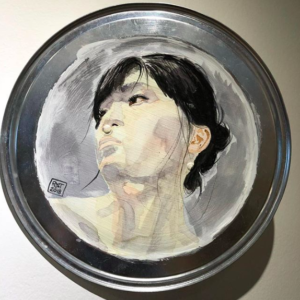
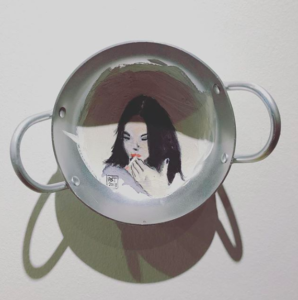
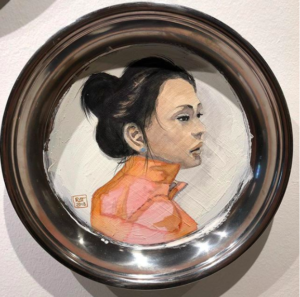
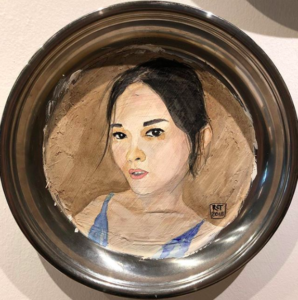
4) What was your process like in terms of experimenting with the gouache, as a new medium?
I started using gouache with some of my paintings on silk, particularly with blacks. Because silk is a transparent surface and watercolors innately a transparent type of paint, it was very difficult to get the a deep opaque black. Gouaches are something akin to an opaque watercolor (they often have white mixed into the colors to achieve this). I only use gouache when I need to have an opaque and dense area, often in the parts of hair where there is no reflection or gradation. I plan at some point to start more fully painting with gouache to better learn about their properties for future works.
5) Do you plan to continue to make similar work, in this medium and style?
Yes, I’ve continued to work with this medium and as far as the style is concerned, it’s my own style at this point but since I’m still quite new at this type of work, it will probably evolve as I begin to have more mastery over this medium. I really enjoy working with watercolor and am interested in pushing them in ways that perhaps they weren’t intended for.
6) What’s most important to you – as artist? (Medium, concept, audience, object, process…)
That’s a good question. Also the prioritization of these things have changed over time for me. If you asked me 15 years ago, it would have been concept and audience at the top, where I was trained in performance art and a relatively new graduate from an American art education that encourages the conceptual development of art work. Today, I would say material and craft/technique are at the top. I’ve personally become more introverted and enjoy spending a lot of alone time in my studio working and experimenting. I read books, watch tutorial videos and am always trying to learn. At the end of the day, I create mostly objects first and concepts later, where early in my career these two things would have been inverted.
7) What do you hope people take away or feel from this series of work?
I usually don’t have expectations. Of course, I would hope that they would be appreciated but appreciation can be very broad. I was pleased with how they were installed in the SPRMRKT STPI location – perhaps also being an F&B and lifestyle company, that they were painted on cooking and service utensils, they fit quite nicely with the whole environment. From a conceptual standpoint, I would hope that those who read the description might reconsider the relations between gender, work/service and language. And finally, I would hope that people might think, “hey, these paintings are pretty good for a sculptor!” I’m happy too that two of the works, so far, have literally been “taken away” and found new homes by collectors!

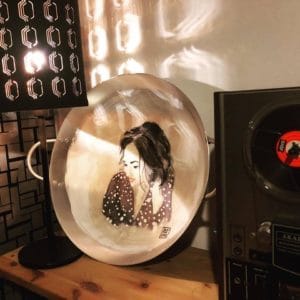
8) What’s next for you, in 2018/19?
SPRMRKT was my first exhibition of 2018. Following that I spent 45 days as an artist in residence with Bangkok University that culminated in a two floor solo exhibition with 27 new works ranging from installation, sculpture and painting. In this exhibition I continued working with the watercolor on metal for a series of new works with same materials used for Prophilia. In June, I was commissioned to do a public artwork with the DISINI project at Gillman Barracks working with the Chan +Hori gallery. The remaining 2018 will close out with a small group exhibition in Bandung, Indonesia and a large installation in Krabi as a part of the Thailand Biennale. As for 2019, it’s currentlywide open – but hopefully I can create new work for the next Art Basel Hong Kong with the de Sarthe gallery who represents my work. Perhaps another exhibition in Singapore.. last year an installation was acquired by the Singapore Art Museum and has yet to be shown in Singapore.
